Do you have red bumps on your inner thighs? Are bumps on thighs cysts or symptoms of an STD? These can affect both females and males. Infection can worsen symptoms. Read on to find out more.
Meaning and causes
Do you have a red tender bump on the inner thigh that hurts? Here are the causes, symptoms, and remedies including rashes and pimples on thighs.
Bumps on thighs after shaving
People often get small bumps after shaving this area more frequently using razor blades or shaving tools. The bumps result in itchy thighs but cause irritation especially during body movements involving the inner thighs or sitting on hard surfaces and for many hours.
Rashes
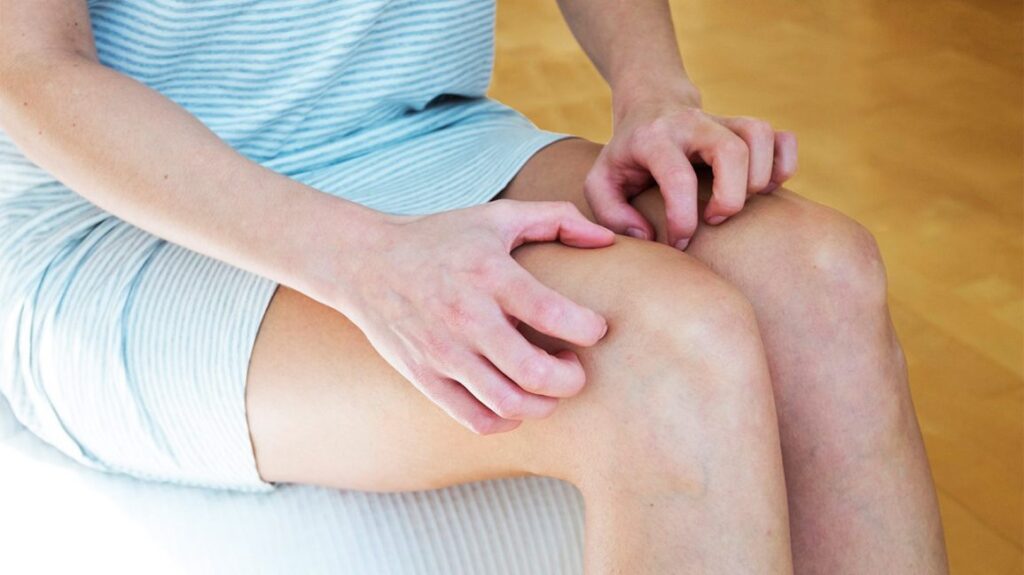
A rash on thighs can be in for of small bumps or eruptions which lead to change in skin texture hence changing the appearance. What causes a rash in this area including the inner or back of thighs?
Reactions to certain substances like medicines, in specific deodorants and certain foods, can result in skin rashes to areas of your body. Your immune system plays a central role in identifying the very substance present or in contact with your body has potentially harmful effects.
Unfortunately or lucky enough, not everyone is allergic to a particular substance or food that causes a body reaction for someone else. It is therefore difficult to know when such reactions are likely to occur until you really experience it. Certain reactions are controllable. However, some are life-threatening.
Contact is a more common manner that results in rashes after one is exposed to something they are allergic to. These may include soap fragrant, shower gels or detergent and body lotions. Do not forget infections can cause skin rashes including the inner thighs.
Hidradenitis suppurativa and friction between thighs
Hidradenitis suppurativa is a medical term that refers to the inflammation of the hair follicles. It is caused by blocked hair follicles. Doctors do not fully understand the reasons behind it but the blockage is linked to genetic predisposition, hormone disorders, being overweight or as a result of immune system response among other risk factors.
HS starts as a painful pea-sized bump or lump. Signs and symptoms of HS bumps include
- Red bumps with tenderness especially on inner thighs
- Odor or smelly pus after the red bumps have raptured
- Slow-healing wounds
- Sometimes HS is characterized by the formation of blackheads
Friction is also a risk factor. Many people who are obese have higher chances and can get this condition if the thighs are in constant rubbing.
It is common in females at puberty and grownups who are in the 30s and include men and women. A variation in hormones is what nearly anyone female expects during pregnancy. Doctors examine physical body changes and study pre-menopause hormones together with an outlook of the hormonal disorder as a risk factor for HS in females. (Especially when irregular or abnormal periods.)
Hidradenitis suppurativa becomes chronic or recur often if the affected individual fails to detect at inception. If it is not treated complications and infections may develop depending on other areas where it occurs.
Folliculitis
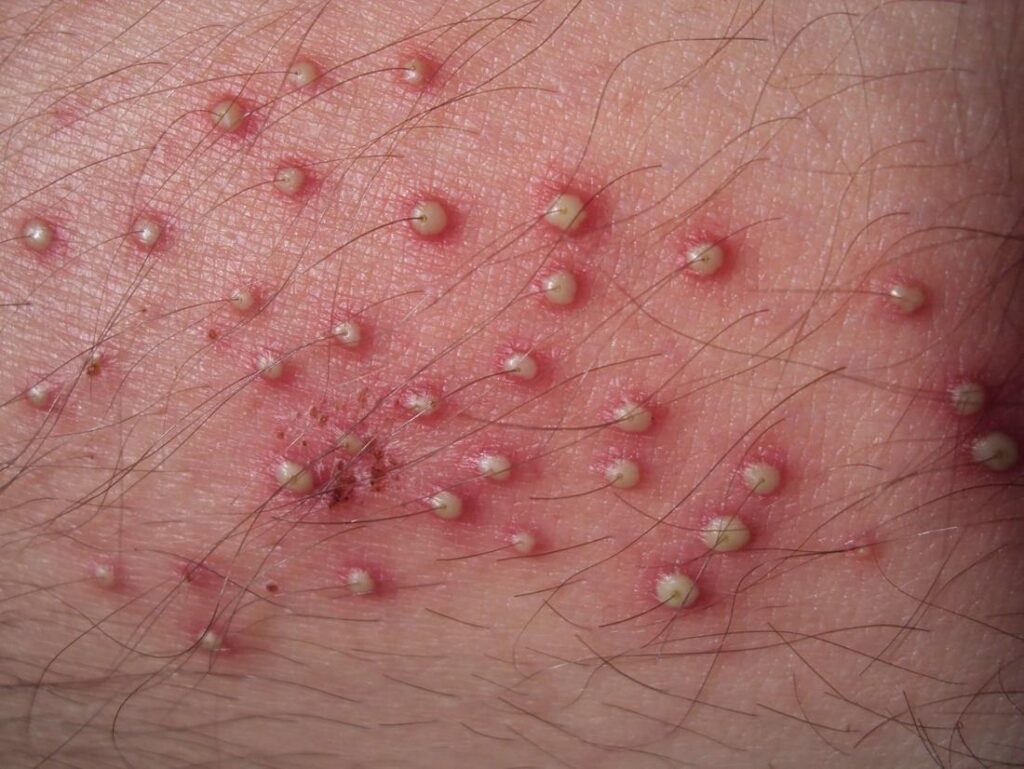
Apart from Hidradenitis suppurativa, folliculitis is another skin disorder associated with hair follicle inflammation. Unlike HS, the inflammation of hair follicles is due to several strains of bacteria.
It is mainly characterized by itching and formation of painful fluid-filled bumps.
In severe cases, folliculitis almost always becomes chronic and treatment may be involved to relieve the symptoms. Sometimes mild cases of folliculitis are experienced as compared to other parts of the body like on the scalp.
Acne bumps and pimple on thighs
Acne and pimples can also cause bumps on your thighs including the back and on inner thighs. Acne bumps start as a red swollen area of the skin and then develop into a larger, pus-filled pustule.
Pimples here may be seasonal or come and go. Typical skin pimples are always painful. When infected pimples easily become red and can be filled with white pus or discharge. Unlike acne bumps, pimples may resolve on their own.
Insect bites
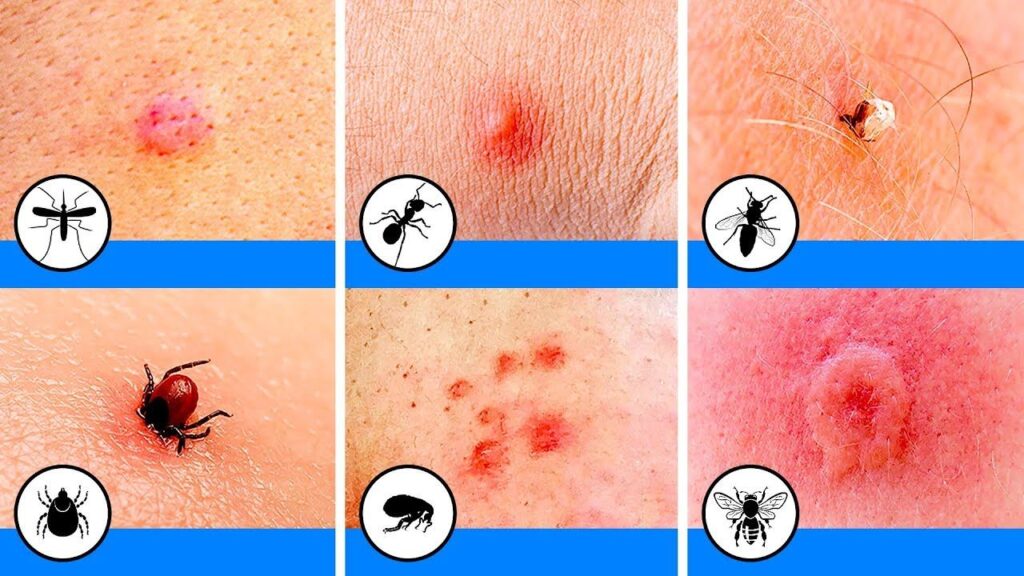
Bites may be thought to be uncommon but are possible causes of itchy bumps that are normally small. The symptoms of bites depend on the suspected culprit but sometimes identifying the bites may pose a challenge when finding out the right treatment or remedy.
Getting rid of such bites is quite easy since insects and parasites are controllable. Find the right measures to prevent future insect bites or ask your physician to help you out in case you get stuck.
Red bumps on thighs and STD symptoms
What causes red bumps on the inner thighs? In many cases, they are often accompanied by pain. Irritation and infection can result in redness.
Pimples on your thighs, razor bumps or ingrown hair and rashes can become infected more easily since the nature of this area allow infection-causing microorganisms to thrive in sweaty and warm conditions.
According to New Health Advisor, friction on the inner thigh surface would result in a heat rash. Heat rash causes itchy bump eruptions. It is common during the summer or hot weather more so when there is increased perspiration or sweating. In addition, people whose thighs rub against each other are more likely to get red bumps after shaving.
Insect bites can also cause small or tiny itchy and painful bumps on this area. As they bite they can irritate skin tissues or release toxic substances into your system. Many of the insects and small animals are parasitic. They include fleas, chiggers, and gnats.
Red bumps on inner thighs are symptoms of certain skin conditions typical of skin inflammation like folliculitis and Hidradenitis suppurativa.
Can STDs cause red bumps here? According to Mayo Clinic, STDs like genital herpes can cause red bumps in the genital area. In fact, herpes infection is symptomatic of warts on the vagina, anus, and penis. However, pain and itching would be experienced on inner thighs.
How to get rid of bumps on thighs – Treatments and remedies
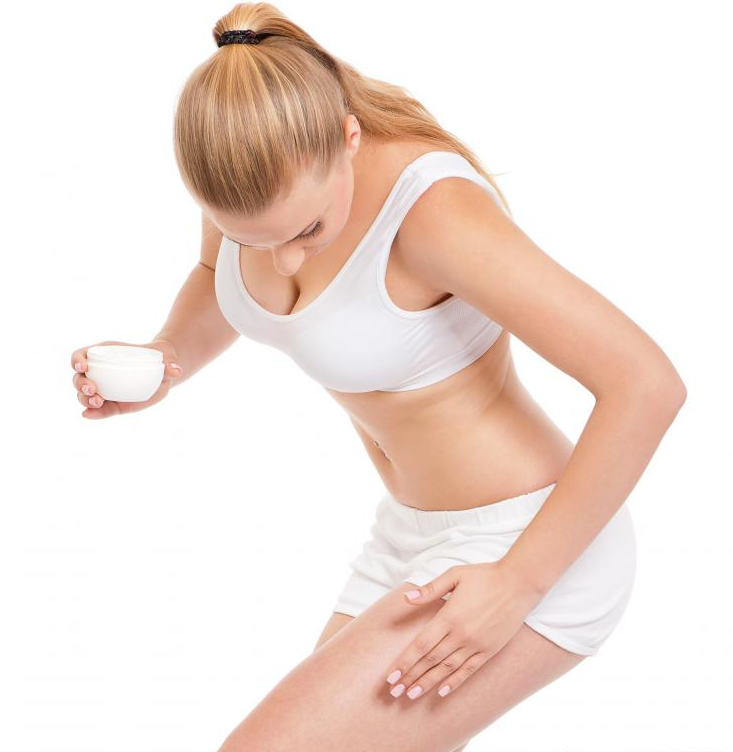
Treating bumps on thighs is a challenge when you don’t consider the causes. The occurrence rashes due to exposure or contact with skin, insect bites and friction between inner thighs can be avoided.
1. Treating and nursing tips
Below are methods for managing thigh bumps including pimples and treating them.
Topical treatment options
These include cleansers, exfoliating creams and antiseptic medicines to help fight infections. Gentle exfoliation of the thigh area is not only a way of preventing but also enhancing shedding of the skin by removing accumulated dead cells.
Cleansing is yet another crucial method of treating pimples. This method helps to clear the pores by removing excess body oils together with sweat and dirt. Keep in mind that if you choose the wrong cleansing products you may be surprised to realize you are getting more pimples.
Moving on, if you notice signs of infection wash your thighs with benzoyl peroxide or solutions labeled 2% salicylic acid. Additionally, you can regularly apply Tea tree oil, apple cider vinegar or turmeric as remedies to address minor infection symptoms.
Other topical medication
When pimples cannot respond to the above treatments consult your doctor. Examples of topical treatments that doctors prescribe include acne treatments.
Above all strive to keep your keep the pimples on your thighs free from infections since it can worsen the symptoms.
2. Keratosis pilaris thigh treatment
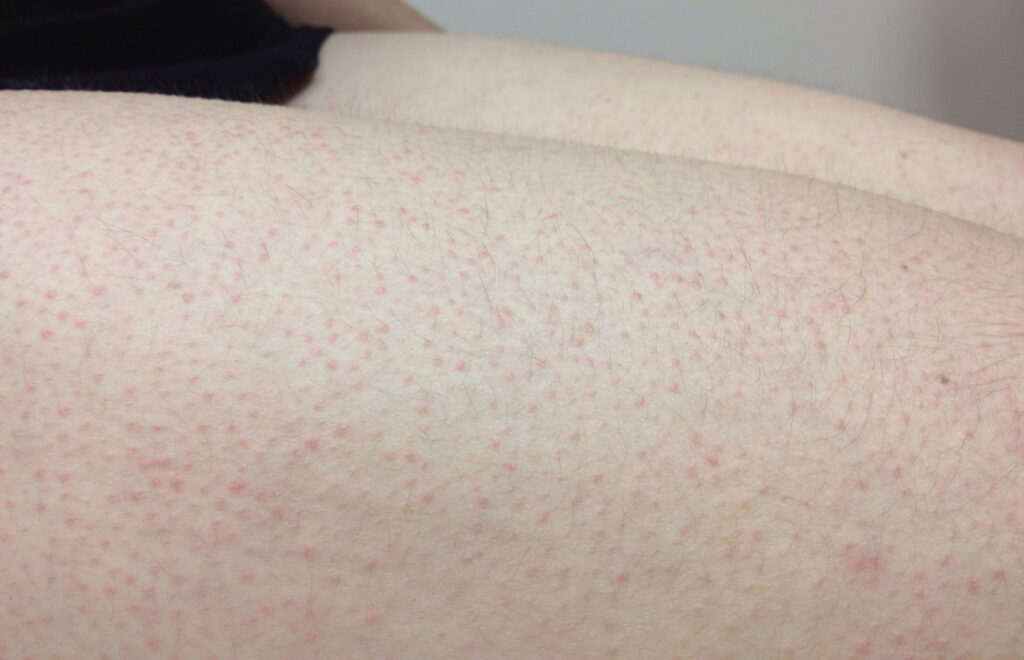
Managing Keratosis pilaris is demanding due to its chronic nature. Getting a total cure is quite difficult. Nevertheless, affected individuals need to constantly keep their skin moistened and cleaned.
Number one keep your thighs clean always. Gentle cleansing is recommended as opposed to aggressive washing which can horribly dry out the skin. Individuals affected by keratosis pilaris should avoid fragrant containing soaps or solutions made from chemical ingredients.
Second, individuals with a characteristic dry skin require a deep moisturizing system included in the skin skincare routine. Hydrating your skin removes the sandpapery skin texture.
Cosmetic treatments like microdermabrasion or chemical peeling are optional. Above all consult your dermatologist if you need more advanced treatment mentioned. Other medications that need consultation include urea, immunomodulators, and vitamin A-based treatments.
3. General remedies
Bumps on thighs and pimples can cause pain. So, observe the following simple remedies comprising DOs and DON’Ts.
- Partial lifestyle changes by avoiding body lotions and cosmetic practices in unhygienic conditions. Replace your tight minis and jeans with more breathable
- Do not scratch the itchy bumps with your fingernails
- Avoid harsh body washing solutions a soaps
- Keep your thighs clean after body workouts while avoiding sweaty pants when exercising
- Keep off foods that trigger the release of more sebum during puberty and periods
4. Remedies for bumps and rashes
It is generally safe and reasonable to attempt these remedies after having consulted your physician about the problem you have on your thighs. In addition, most of these natural remedies will help you in controlling the symptoms like swelling, itching, and inflammation.
Apple cider vinegar

Do you have inner thigh rashes and suspect it to be a result of contact with an allergen? This remedy can be of great help if you give it a try. However, it heals or clears avoid areas where the source of such allergens.
Dilute ascorbic acid
Ascorbic acid has vitamin C which is a vital ingredient. Besides the ability to fading skin, its antioxidant property helps in healing.
Oatmeal
Individuals with rashes who experience irritation can benefit from this remedy. They can take a bath or soak their thighs or whole body oatmeal.
Place 4 cups of uncooked oatmeal in a disinfected water tub with warm water. Wash or cleanse your body with a mild solution. Let your body dry without wiping or using a towel and let your body soak in the solution. You can relax for 10 minutes and repeat the procedure as necessary.
Vitamin E oils – olive or cod liver oils
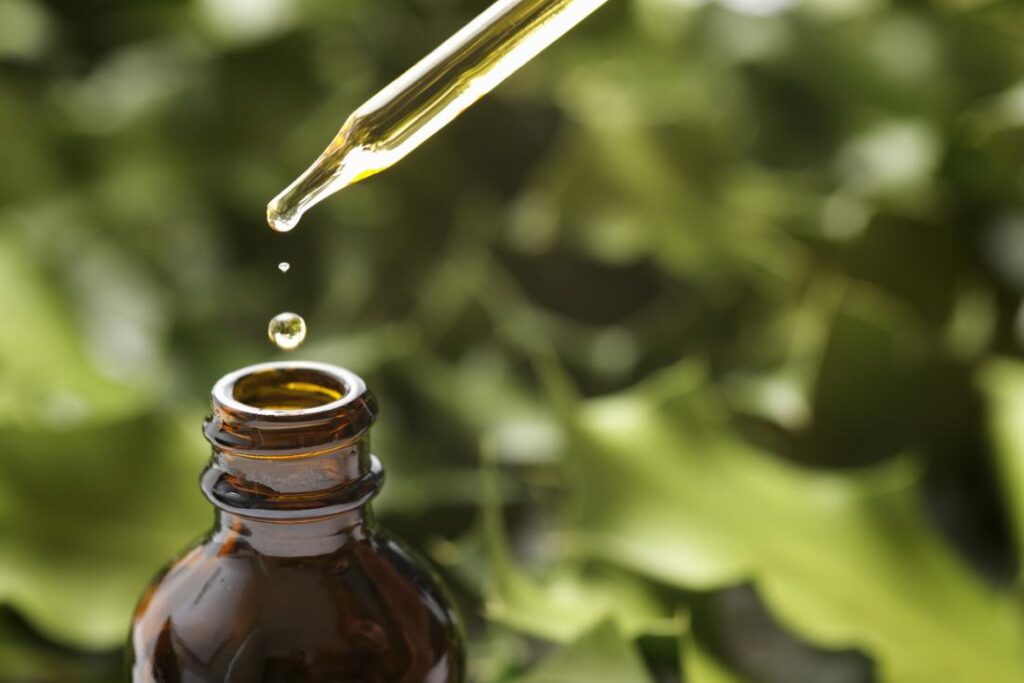
This oil is a super vitamin E source essential for healing rashes. Apply to the affected area once or twice a day. Olive oil can reduce redness due to rashes caused by contact dermatitis or allergic reactions on the skin.
When to see your doctor
Seek medical attention when bumps on thighs look abnormal or grow huge or develop a lump on the inner thigh. When the pain is unbearable or persists for more than a week or two without signs of improving do not sit back.

